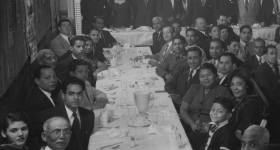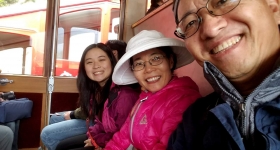Image from Pew Research Center's report, "The Rise of Asian Americans."
Sometimes, a two-page press release can have greater impact on race
relations in the United States than an entire report. That certainly
seemed to be the case last week, when the Pew Research Center put out a
215-page report on the growing importance of Asian Americans.
The report had many commendable aspects, including presenting new data on
the six largest Asian American groups, adding to our knowledge from past demographic
studies and surveys. It presented a
trove of graphs, maps, and tables for the largest national-origin groups. Unfortunately,
it also prioritized questions asked of Asian Americans -- regarding their
parenting styles and their own stereotypes about Americans -- that seemed more
concerned with Amy Chua’s Battle Hymn of the Tiger Mother than with the
priorities of Asian Americans themselves, either as revealed in past surveys or
as articulated by organizations serving those communities. And the demographic
analysis did not adequately cover national origin groups whose economic
outcomes are far less promising.
More concerning than the Pew report, however, was the sensationalist
headline on the press release
that introduced the study to news media: Asians Overtake Hispanics in New
Immigrant Arrivals; Surpass US Public in Valuing Marriage, Parenthood, Hard
Work. These few words carried sway in hundreds of newspaper articles in the
first two days of the report’s release, provoking outrage among broad swaths of
the Asian American community, including many researchers, elected officials,
and community organizations.
As one of 15 advisors to the project, I felt blindsided by the press release.
Words failed me as I read it for the first time, as we had not gotten a chance
to review it. The dominant narrative in the release reinforced the frame of
Asians as a model minority, stereotypes that the advisors had strongly objected
to in the only meeting of the group two months ago. What we contested in private
then, and what others are challenging in public now, is a monolithic frame that
often renders invisible the struggles of many who fall under the Asian American
label.
What made this press release particularly troubling, however, were the
invidious comparisons it seemed to invite, of a racial group that is overtaking
Hispanics and other Americans in a metaphorical race for national supremacy. As
many critics have rightly noted, this zero-sum frame has been invoked time and
again since its formal articulation
in 1966 -- when Japanese and Chinese Americans were valorized in relation to
other minority groups, and yet still viewed as perpetually foreign. And the
model minority myth has often had detrimental effects, from inviting resentment
and violence
against Asian Americans to masking problems
internal to the group.
This is unfortunately not the first time that Pew has presented research on
minority populations that has confused matters more than clarified. In October
2010, its executive summary and lead graphic signaled that Latinos were divided
on unauthorized immigration, even though much of the data in the report showed overwhelming
Latino unity on a host of issues, including support for legalization (86%) and
opposition to Arizona’s SB1070 (79%). Similarly, it framed the jobs recovery in
October 2011 in zero-sum
terms, as immigrants gaining and the native-born losing -- a claim that researchers at the
University of Southern California found to be unusually sensitive to how the
study was conducted.
In the case of Pew’s Asian American press release, the damaging effects may
have been more significant, mostly because there are so few think-tanks that
conduct research on Asian Americans, and Pew made scant mention of prior
studies to provide a sufficient basis for comparison. What could have been a
celebratory moment for all, showcasing the need for significant and sustained
attention to the Asian American population, instead became a contested debate
over a frame with a tangled history.
Still, I remain optimistic. At the press launch of Pew’s report, I noted
that the study is a conversation starter, and this is true in many ways. It can
start a helpful public conversation about the opportunities and challenges we
face as a country, and how Asian Americans fit into that mix. It can initiate a
dialogue among researchers, community leaders, and news media on how better to
report on minority communities. Hopefully, it will also start a conversation
internally at Pew, on the care Pew needs to exercise in publicizing its
research, particularly given its outsized role in shaping news coverage about
minority populations.
* * *
Karthick Ramakrishnan is associate professor of political science at the
University of California, Riverside and fellow at the Wilson Center in
Washington, DC.
You've just read a post from Across the Desk: a collaboration of Asian American journalists and scholars. See here
for more in the series. Scholars and journalists interested in
contributing, please email the series editor at
erin[at]hyphenmagazine[dot]com.









Comments
Dear Editors,
I am writing in response to an op-ed
by Karthick Ramakrishnan, “When Words Fail: Careful Framing Needed in Research
on Asian Americans,” published on June 27 about the recent report by the Pew
Research Center, “The Rise of Asian Americans.”
The full report – all 215 pages
rich in original, empirical data – paints a complex, nuanced portrait of a
high-achieving but highly heterogeneous group. It is based on government data
as well as our own rigorous nationally representative survey of the full Asian
American population. Throughout this research project, from the development of
the survey questionnaire to the final draft of the report, we consulted with
and incorporated feedback from our panel of 15 Asian American scholars who
served as external academic advisers, including Mr. Ramakrishnan.
Mr. Ramakrishnan writes that his concerns are primarily around the
media coverage of the report, and the
headline of the press release: “Asians Overtake Hispanics in New Immigrant
Arrivals; Surpass US Public in Valuing Marriage, Parenthood, Hard Work.”
However, when they had a chance to review it in advance, neither Mr.
Ramakrishnan nor any of our advisers took
issue with the lead paragraph and first chart of the report, from which the
headline of the press release was derived. The first paragraph of the report
reads: “Asian Americans are the highest-income, best-educated and
fastest-growing racial group in the United States. They are more satisfied than
the general public with their lives, finances and the direction of the country,
and they place more value than other Americans do on marriage, parenthood, hard
work and career success.” The first chart of the report shows the percentage of
Hispanic and Asian immigrants from 2000 to 2010 and is titled, “Meet the New
Immigrants: Asians Overtake Hispanics.” All
of these assertions are supported by vast amounts of empirical data in a
lengthy report that also quantifies the often sizable differences within
different parts of the Asian American community on these and other key
socioeconomic and attitudinal measures.
To provide additional context beyond
our report, we pointed journalists from prominent media outlets toward Mr.
Ramakrishnan and other advisers before the report was released precisely
so the voice of scholars, and any additional nuance they wished to share, could
be included in the media narrative. We invited Mr. Ramakrishnan to the launch
event – along with other Asian American scholars and civic leaders – to ensure
that such voices were represented. And after the release, we encouraged
scholars who felt that the media coverage fell short to contribute op-eds,
articles and media appearances to highlight
facts and themes beyond the scope of our study.
As a nonpartisan fact tank that does
not engage in any issue advocacy or make policy recommendations, Pew Research
Center strives to shed light on important issues of the day by asking key
questions and sharing what we find with the public, including advocacy groups.
We do not advocate on behalf of any issue or alter our findings to support a
particular group’s agenda. Through transparent and rigorously pursued
methodologies, we provide data and facts that add to the conversation and
provide a jumping off point for further inquiry and understanding.
A number of panelists at our launch
event, including Mr. Ramakrishnan, remarked that one value of this report is
that it might trigger a national conversation about a population group that has
been growing in number and importance, but to a large extent has remained under
the national radar screen. As Mr. Ramakrishnan said then,
“What this report is really good at is it presents facts. But in terms of
analyzing the dynamics that produce those facts, this is when you need to talk
to social scientists and community organizations, and other people, right?
Because again it’s a conversation starter and we need to broaden this
conversation, and I’m thrilled that Pew has done this.”
That conversation has begun and we hope it
continues. We look forward to participating in it.
Vidya Krishnamurthy
Communications Director
Pew Research Center
Washington, DC